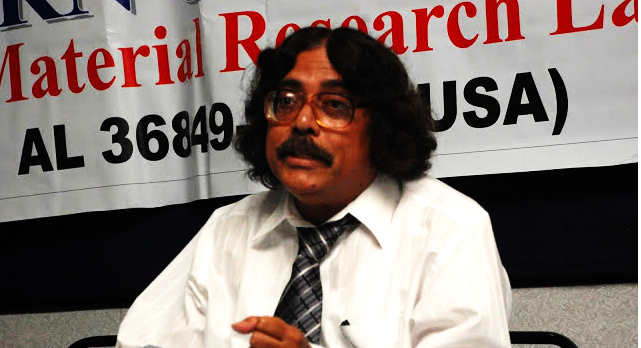Masses Clamor For Justice To Globally Renowned Scientist Professor Mrinal Thakur

New Delhi, June 6, 2023: Demanding immediate recognition of Professor Mrinal Thakur, the Director of Photonic Materials Research Laboratory at Auburn University (USA), by the Royal Swedish Academy of Sciences (RSAS) by conferring Chemistry Nobel Prize to him, a section of Indians took to the streets to make their clamor audible to Sweden.
Despite having discovered the Nonconjugated Conductive Polymers and the correct fundamental basis of conductive polymers, Professor Thakur was neither recognized nor given his due credit for 22 long years.
In 2000, the Chemistry Nobel Prize was given to Heeger, MacDiarmid and Shirakawa for the discovery of “Conductive Polymers” while they discovered only the “Conjugated” conductive polymers. But the RSAS did not recognize the discovery of “Nonconjugated” Conductive Polymers by Professor Thakur.
His case is a classic example of total violation of the academic norms as well as the human rights. If conductive polymer discovery has been recognized by the RSAS, why not give equal status to the “Nonconjugated” Conductive Polymers discovered by Professor Thakur and duly recognize the “Correct” basic assumption made by him?
This is a glaring example of violation of both the academic standards and human rights by the RSAS. The Indian public demands that the RSAS must confer the Chemistry Nobel Prize to Professor Thakur in 2023 for his path-breaking discoveries.
Earlier, Professor Thakur requested the Prime Ministers of Sweden and India and the President of the USA to take up the long pending issues with the RSAS to arrive at meaningful resolutions – nothing has transpired as yet!
Though the RSAS is in agreement with Professor Thakur that the fundamental basis given in the document preserved for the 2000 Nobel Prize in Chemistry is incorrect / nonfactual, the RSAS has not taken steps to make requisite corrections and accord due credit to Professor Thakur.
He made this discovery around the same time as that of Heeger, MacDiarmid and Shirakawa. Here, the blatant violation of academic norms and human rights violation come to light.
Though Professor Thakur was nominated for the Nobel Prize in Chemistry for 22 times, he was not given it. To top it, the Chemistry Nobel Prize in 2014 was given to persons who allegedly plagiarized from Professor Thakur’s experimental and theoretical works in nonlinear optics.
As it appears at the website of The Nobel Foundation,“ key property of a conductive polymer is the presence of conjugated double bonds along the backbone of the polymer. In conjugation, the bonds between the carbon atoms are alternately single and double.”
Also, “For a polymer to be able to conduct electric current it must consist alternately of single and double bonds between carbon atoms”. These fundamental statements are nonfactual / incorrect since these disregard existence of “Nonconjugated” Conductive Polymers and their impacts.
Professor Thakur used Coulomb Correlation theory which applies to both Nonconjugated and Conjugated Conductive Polymers while other theories developed only considering Conjugated Conductive Polymers may lead to incorrect conclusions. “Conjugated” conductive polymer indeed is a special case of “Nonconjugated” conductive polymer.
The Nobel Committee failed to follow their statutes (Statutes of The Nobel Foundation) in decisions on 2000 and 2014 Nobel Prizes in Chemistry. The relevant statute (1) goes as follows: the prize will go “to the person who shall have made the most important chemical discovery or improvement”. Can allegedly “incorrect” or “plagiarized” works be considered a “most important chemical discovery”?
Not really!
The research conducted by Professor Thakur proved the “Nonconjugated Conductive Polymers” can effectively absorb radioactive iodine emitted from nuclear reactors saving the Mother Earth. Millions of human lives, flora and fauna across the globe can be safeguarded by creating shields made of the Nonconjugated Conductive Polymers.
Mass deployment of such shields can protect the people against radiation poisoning and different ailments including thyroid cancer that radioactive iodine causes. Currently, there is a huge demand for the potassium-iodide pills throughout the European Union (EU) for fear of nuclear radiation due to the ongoing Ukraine-Russia war.
In the backdrop of this fear of nuclear war, the world leaders should try to impress upon the RSAS to recognize the radiation absorbing capacity of the “Nonconjugated” Conductive Polymer-based shielding technology. The global leaders must come forward in sealing all nuclear reactor facilities around the world with this protective shield to save human lives.
Wrath of Media Against the Royal Swedish Academy
Though the RSAS is in agreement with Professor Thakur, it is ignoring the demand of the Indian Press to make the requisite corrections and officially provide due credit to Professor Thakur.
The Indian Press warned that there is deep public discontent over the following critical issues which have remained unaddressed:
- No credit was given to Professor Thakur in 2000 Nobel Prize and afterwards for his discovery of “Nonconjugated Conductive Polymers.”
- Royal Swedish Academy is yet to correct the document preserved at the Nobel Foundation website despite repeated requests. The document states a polymer must be conjugated to be electrically conductive – which is nonfactual and the corresponding theory as given is incorrect,
- Professor Thakur’s research funding was abruptly stopped in 2003 as he brought up the incorrectness and inequity regarding the 2000 Nobel Prize in Chemistry.
- Professor Thakur stakes claim to the 2014 Nobel Prize in Chemistry as well since “Super-resolved Fluorescence Microscopy” (2014 Nobel in Chemistry)is primarily based on earlier nonlinear optical experimental and theoretical studies performed by Professor Thakur and colleagues on organic materials.
Professor Thakur did not receive credit in the 2000 Nobel Prize. Again in 2014, the Nobel Committee did not give him credit for his equation and the underlying fundamental experimental and theoretical works on nonlinear optics that were critical for super-resolved fluorescence microscopy!





